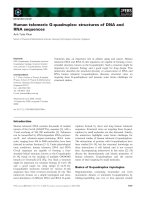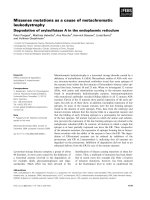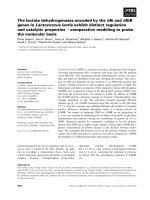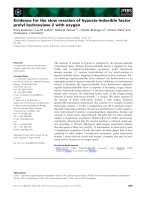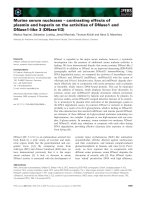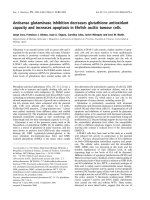Báo cáo khoa học: "Vacuum-assisted breast biopsy: A comparison of 11-gauge and 8-gauge needles in benign breast disease" pptx
Bạn đang xem bản rút gọn của tài liệu. Xem và tải ngay bản đầy đủ của tài liệu tại đây (708.58 KB, 6 trang )
BioMed Central
Page 1 of 6
(page number not for citation purposes)
World Journal of Surgical Oncology
Open Access
Research
Vacuum-assisted breast biopsy: A comparison of 11-gauge and
8-gauge needles in benign breast disease
Markus Hahn*
1
, Stella Okamgba
2
, Peter Scheler
2
, Klaus Freidel
2
,
Gerald Hoffmann
2
, Bernhard Kraemer
1
, Diethelm Wallwiener
1
and
Ute Krainick-Strobel
1
Address:
1
Clinic for Obstetrics and Gynaecology, University of Tuebingen, Germany and
2
Clinic for Obstetrics and Gynaecology, St. Josefs-
Hospital, Wiesbaden, Germany
Email: Markus Hahn* - ; Stella Okamgba - ; Peter Scheler - ;
Klaus Freidel - ; Gerald Hoffmann - ; Bernhard Kraemer - ;
Diethelm Wallwiener - ; Ute Krainick-Strobel -
* Corresponding author
Abstract
Background: Minimal invasive breast biopsy is standard care for the diagnosis of suspicious breast
lesions. There are different vacuum biopsy (VB) systems in use. The aim of the study was to
determine the differences between the 8-gauge and the 11-gauge needle with respect to a)
diagnostic reliability, b) complication rate and c) subjective perception of pain when used for
vacuum-assisted breast biopsy.
Methods: Between 01/2000 and 09/2004, 923 patients at St. Josefs-Hospital Wiesbaden
underwent VB using the Mammotome
®
(Ethicon Endosurgery, Hamburg). Depending on
preoperative detection, the procedure was performed under sonographic or mammographic
guidance under local anaesthesia. All patients included in the study were followed up both clinically
and using imaging techniques one week after the VB and a second time after a median of 41 months.
Excisional biopsy on the ipsilateral breast was an exclusion criteria. Subjective pain scores were
recorded on a scale of 0 – 10 (0 = no pain, 10 = unbearable pain). The mean age of the patients
was 53 years (30 – 88).
Results: 123 patients were included in the study in total. 48 patients were biopsied with the 8-
gauge needle and 75 with the 11-gauge needle. The use of the 8-gauge needle did not show any
significant differences to the 11-gauge needle with regard to diagnostic reliability, complication rate
and subjective perception of pain.
Conclusion: Our data show that there are no relevant differences between the 8-gauge and 11-
gauge needle when used for VB. Under sonographic guidance, the use of the 8-gauge needle is
recommended for firm breast tissue due to its sharp scalpel point and especially for complete
removal of benign lesions. We did not find any advantages in the use of the larger 8-gauge needle
compared to the 11-gauge needle in the mammography setting. The utilisation costs of the 8-gauge
needle are somewhat higher.
Published: 19 May 2008
World Journal of Surgical Oncology 2008, 6:51 doi:10.1186/1477-7819-6-51
Received: 3 December 2007
Accepted: 19 May 2008
This article is available from: />© 2008 Hahn et al; licensee BioMed Central Ltd.
This is an Open Access article distributed under the terms of the Creative Commons Attribution License ( />),
which permits unrestricted use, distribution, and reproduction in any medium, provided the original work is properly cited.
World Journal of Surgical Oncology 2008, 6:51 />Page 2 of 6
(page number not for citation purposes)
Background
Vacuum-assisted breast biopsy (VB) under sonographic
[1-4] and mammographic [5,6] control is recognised as an
established method of minimal invasive tissue extraction.
VB is recommended as a diagnostic method in the S3-
guidelines for the early recognition and diagnosis of
breast cancer [7]. In contrast to open biopsy, the tech-
nique represents a minimal invasive intervention for the
clarification of unclear focal lesions in the breast, and it
can furthermore be used for the diagnostic-therapeutic
complete removal of benign lesions [8-12]. In contrast to
fine needle aspiration and minimal invasive high speed
core needle biopsy with the 14-gauge needle, the diagno-
sis of the smallest solid lesions of the breast as well as
microcalcification are certainly possible with this tech-
nique. VB consequently closes the gap between open
biopsy and the small calibre minimal invasive procedures
and completes the spectrum of techniques.
The mammographic VB was first clinically tested by Steve
Parker in 1994 (14-gauge). Since 1996, the 11-gauge nee-
dle has been routinely used in the Mammotome
®
-System
in clinical practice. The Mammotome
®
-vacuum biopsy
system was completed with addition of the 8-gauge nee-
dle in 2001. A further VB system, the Vacora
®
, [13] works
with a 10-gauge needle diameter. Summaries of the
dimensions of the various biopsy needles and the tissue
cylinders (figure 1) are shown in tables 1 and 2 (figure 2
and 3).
The aim of this study was to evaluate the differences
between the 11-gauge and 8-gauge needles of the Mam-
motome®-System with regard to a) diagnostic reliability,
b) complication rate and c) subjective perception of pain
both immediately postoperatively and on follow-up.
Methods
Patient selection
Between 01/2000 and 09/2004, 923 patients at St. Josefs-
Hospital Wiesbaden underwent VB using the Mammo-
tome
®
(Ethicon Endosurgery, Hamburg). 123 patients
could be included in the study. Inclusion criteria were
benign histology and complete follow up (inspection,
palpation, mammogram and sonogram). An open biopsy
was not performed after extirpation by VB.
Operative interferences on the ipsilateral side were exclu-
sion criteria. Consequently, only patients with benign his-
tology were followed up in the scope of this study, since
patients with malignant histology needed to be supported
with operative treatment. The VB was performed for
lesions classified as BI-RADS
©
3, 4 and 5. Imaging control
was performed using the technique which gave the most
accurate representation of the findings. 48 patients (39%)
were biopsied with the 8-gauge needle and 75 (61%) with
the 11-gauge needle.
The 14, 11 and 8 gauge tissue cylindersFigure 1
The 14, 11 and 8 gauge tissue cylinders.
The 11 and 8 gauge needleFigure 2
The 11 and 8 gauge needle.
World Journal of Surgical Oncology 2008, 6:51 />Page 3 of 6
(page number not for citation purposes)
The mean patient age was 53 (30–88) years. The median
follow-up period was 41 (5 – 64) months.
Biopsy technique
All biopsies were performed using VB-equipment from
Ethicon Breast Care Mammotome
®
. A table from Fischer
Imaging
®
was used for stereotactic procedures. Ultrasound
equipment HDI 5000 from ATL
®
was used for sonographic
biopsies in Sono-CT mode. All biopsies were performed
as an out-patient procedure. 20 ml of Prilocaine 1% with
epinephrine 1:200000 was used as local anaesthetic. It
was applied subcutaneously and not peritumorally in
order to not interfere with the imaging. Further drugs were
not administered. The biopsy site was compressed postop-
eratively until bleeding ceased. The incision site was cov-
ered with a Steri-Strip plaster. Finally, a thorax pressure
bandage was applied for 24 hours.
Follow-up
Haematomas were differentiated according to need for
revision and superficial cutaneous development. Superfi-
cial cutaneous haematomas were recorded according to
persistence in days.
Infections requiring antibiotic treatment as well as cutane-
ous scar formation in the incision area were also evalu-
ated. In order to evaluate patient acceptance, all patients
were questioned about their subjective perception of pain
immediately postoperatively, 1 week postoperatively and
at the last follow-up appointment. A pain scale from 0 (no
pain) to 10 (unbearable pain) was used for this.
Statistical analysis
Data was collected using Microsoft Access, and the statis-
tical analysis was carried out using STATISTICA
®
. Chi
squared tests were used. Whether or not the perception of
pain differed between the patients and over the three
measuring times was tested with the help of a multi-vari-
ant analysis (MANOVA). Post hoc comparisons were sta-
tistically confirmed using a t-test. The description of mean
values was completed using standard deviations (MW ±
SD).
Results
A correct diagnosis could be made for all 123 patients
using VB. No repeat biopsies had to be performed. No
biopsies were abandoned during the procedure. Out of
the 123 biopsies performed, a total of 46 fibroadenomas,
18 cases of sclerosing adenosis, and 38 cases of fibrocystic
mastopathy, 11 cases of scarring following a previous sur-
gical procedure, 8 papillomas and 2 cases of other benign
histology were diagnosed. All 8 papillomas which were
included in the study showed no signs of atypia and were
completely removed under sonographic imaging. There-
fore open biopsy was not performed after recommenda-
tion in an interdisciplinary tumour conference. No
residues were found in any of these cases at the follow-up
examination. A list of the histological results stratified
according to needle size is shown in table 3.
It should be noted that only benign lesions which did not
need to be reoperated could be included in the study. Fol-
low-up would otherwise not have been possible, as an
operation would have followed. No malignancies were
diagnosed at the follow-up examination. Similarly, no res-
idues requiring biopsies were found.
48 patients (39%) underwent biopsy using the 8-gauge
needle and 75 (61%) with the 11-gauge needle. An over-
view of the results is shown in table 4.
Diagnostic reliability
The mean diameter of the lesions using the 8-gauge nee-
dle was 16 mm (4–50 mm), and with the 11-gauge needle
was 15 mm (2–36 mm). Out of the 48 biopsies performed
with the 8-gauge needle, the lesion was completely
removed in 28 (58%) cases. A representative biopsy was
performed in 20 (42%) cases. Using the 11-gauge needle,
complete removal was achieved in 35 (47%) cases, and a
representative removal in 40 (53%) cases in this group.
There was no significant difference (p = 0.2) in diagnostic
reliability between the 8-gauge and 11-gauge needle.
Haematomas
Haematomas requiring revision did not occur in either
the 8-gauge or the 11-gauge group. Superficial cutaneous
11 and 8 gauge needle (sideview)Figure 3
11 and 8 gauge needle (sideview).
Table 1: External measurements of the needles and incision
length on the skin
Width in mm Height in mm Incision length in mm
11G 3,1 4,6 4
10G 4,0 4,0 4,5
8G 4,3 6,0 5
World Journal of Surgical Oncology 2008, 6:51 />Page 4 of 6
(page number not for citation purposes)
haematomas were noticed in 36 (75%) patients after the
8-gauge biopsy and 57 (76%) patients after 11-gauge
biopsy. The mean persistence of the haematomas in the 8-
gauge group was 13 (2–43) days and 10 (2–56 days) in
the 11-gauge group.
Scars
Noticeable external scars, none of which were aestheti-
cally unacceptable or required correction, occurred 5
times in the 8-gauge group and 8 times in the 11-gauge
group. No significant difference was seen here (p = 0.6).
Perception of pain
The groups did not differ significantly from one another
with regard to subjective pain perception (p = ns). Pain
perception was also similar when the respective question-
ing times were compared (t-Test, p > 0.06). The mean sub-
jective pain score immediately postoperatively was 3.5 ±
2.6 in the 8-gauge group and 3.0 ± 2.7 in the 11-gauge
group. One week postoperatively, the mean pain score
was 0.9 ± 1.4 in the 8-gauge group and 0.8 ± 1.5 in the 11-
gauge group. At the last follow-up appointment, the mean
pain score was 0.0 ± 0.3 in the 8-gauge group and 0.1 ± 0.5
in the 11-gauge group. The perception of pain abated
comparably in both patients groups postoperatively
(MANOVA F
2;228
= 140.57, p < 0.001; the difference
between the groups over the questioning times was not
significant (MANOVA F
2;228
= 1.13, p = 0.33). However,
the pain did not only reduce in the week following the
procedure (t-Test, p < 0.001), but also up to the last fol-
low-up appointment and was once again significant in
both groups (t-Test, p < 0.01).
Discussion
The Mammotome
®
-System has been in clinical use with
the 11-gauge VB needle since 1996. In 2001, the system
was completed by the addition of the 8-gauge needle.
The 11G or 8G needle was chosen depending on the size
of the lesion. Use of the 8G needle was recommended
from a size of 15 mm; however the ultimate choice was
made by the surgeon. Since the data were already collected
at the start of 01/2000, i.e., before publications such as,
for example, the consensus recommendation from Krain-
ick-Strobel et al., no reference to literature recommenda-
tions concerning needle choice could be made.
The first impressions of 8-gauge needle with respect to the
cylinder quality as well as the tissue volume withdrawn
per examination time are convincingly good (figure 1).
Even the fragmentation of the tissue cylinder seen with
the 11-gauge needle is rarely seen with the 8-gauge needle.
The increased trauma to the breast tissue suspected ini-
tially has been neither subjectively nor objectively con-
firmed. In contrast, the shortened procedure duration,
which comes as a result of a larger tissue volume being
removed per cylinder, is an advantage for both the patient
and clinician [14]. This evaluation is similar to that of
Diebold et al. [15].
The results of this study show no significant differences
between the two needle sizes. A precise analysis of the pro-
cedure duration was not performed and should be under-
taken in further work. The consensus recommendation for
stereotactic VB related to the 11-gauge needle [5]. This is
due to the fact that the 8-gauge needle was not on the mar-
ket at the time of the consensus finding. The consensus
recommendation for VB under sonographic guidance dif-
ferentiated, however, between an 8-gauge and 11-gauge
needle [2].
According to the consensus recommendation for the
sonographic application of VB [2] and in the light of the
data from Krainick et al. [16] and Hahn et al. [8], it is rec-
ommended that fibroadenomas with a maximum diame-
Table 2: Dimensions of the tissue cylinder dependent on the needle window size
Length in mm Weight in mg Diameter in mm Volume in mm
3
11G 19,4 100 2,16 71
10G 19 170 3,4 170
8G 23 300 3,35 203
Table 3: Histological findings after biopsy
Needle size Fibroadenoma Sclerosing adenosis Fibrocystic mastopathy Scar tissue Papilloma Other
11G 29 12 23 5 4 2
8G 17 6 15 6 4 0
Total 46 18 38 11 8 2
World Journal of Surgical Oncology 2008, 6:51 />Page 5 of 6
(page number not for citation purposes)
ter of up to 18 mm are removed using the 8-gauge needle
and those with a maximum diameter of up to 11 mm with
an 11-gauge needle. However, the assumption that a
larger tissue volume can be removed using a larger needle
is only partly correct. In fact, the maximum tissue volume
which can be removed is limited by bleeding, the size of
the breast and the site of the lesion (e.g. close to the skin
surface) [17].
In 8 cases the histology result showed papilloma without
atypia. In all 8 cases the lesions were completely removed
under sonographic imaging. In all cases the patients
declined open biopsy. It should be pointed out that it is
controversial to follow papillomas following core biopsy
alone.
Based on our data and experience, the use of the 8-gauge
needle for very firm glandular tissue is sensible especially
under sonographic imaging. Exact guidance of the needle
is easier to perform with the 8-gauge needle than with the
11-gauge needle due to the scalpel point on the 8-gauge
needle.
The 11-gauge needle seems to be sufficient for stereotactic
applications. In individual cases, where extensive tissue
removal is necessary or in the case of very firm glandular
tissue, the 8-gauge needle can also be helpful under stere-
otactic guidance.
It ultimately remains an individual decision as to which
needle size the surgeon chooses [18]. A rough orientation
guide for the choice of needle size is given in table 5.
The 8-gauge and 11-gauge needles vary in price, the 8-
gauge needle with its dependence on imaging control
being more expensive than the 11-gauge needle.
Just as with all other new methods, the vacuum breast
biopsy must be further evaluated in clinical use with a
higher number of patients.
Conclusion
Our data show that there are no relevant differences
between the 8-gauge and 11-gauge needle when used for
VB. Under sonographic guidance the use of the 8-gauge
needle is recommended for firm breast tissue due to the
sharp scalpel point, and especially for complete removal
of benign lesions. We did not find any advantages in the
use of the larger 8-gauge needle compared to the 11-gauge
needle in the mammography setting. The utilisation costs
of the 8-gauge needle are somewhat higher.
Table 4: Results
8 g 11 g
Representative removal 20 (41, 7%) 40 (53, 3%)
Complete removal 28 (58, 3%) 35 (46, 7%)
Haematomas requiring revision 0 0
Cutaneous haematomas 36 (75%) 57 (76%)
Mean duration of haematomas in days 13 10
Infection requiring antibiotics 0 0
Noticeable external scar formation 5 (10, 4%) 8 (10, 7%)
Mean pain score immediately postoperatively 3,6 3,2
Mean pain score 1 week postoperatively 0,7 0,6
Mean pain score in follow up 0,1 0,3
Max. lesion diameter in mm 50 36
Min. lesion diameter in mm 42
Mean lesion diameter in mm 16 15
Table 5: Recommended needle size – indications
Diagnosis of microcalcification (stereotactic) 11G
Focal lesions without microcalcification (stereotactic) 8G
Sonographic removal of intraductal, intracystic lesions 8G
Sonographic removal of fibroadenomas up to 11 mm diameter 11G
Sonographic removal of fibroadenomas up to 18 mm diameter 8G
Re-biopsy for failed correlation of suspected diagnosis and histology 8G
Sonographic removal of suspicious lesions smaller than 5 mm 11G
Publish with BioMed Central and every
scientist can read your work free of charge
"BioMed Central will be the most significant development for
disseminating the results of biomedical research in our lifetime."
Sir Paul Nurse, Cancer Research UK
Your research papers will be:
available free of charge to the entire biomedical community
peer reviewed and published immediately upon acceptance
cited in PubMed and archived on PubMed Central
yours — you keep the copyright
Submit your manuscript here:
/>BioMedcentral
World Journal of Surgical Oncology 2008, 6:51 />Page 6 of 6
(page number not for citation purposes)
Competing interests
The authors declare that they have no competing interests.
Authors' contributions
MH and PS were the surgeons who performed all biopsies.
MH and SO designed the current study and collected the
data. MH and KF performed all data analyses. GH, BK,
DW and UK–S edited the manuscript. All authors
approved the final version of the manuscript.
Acknowledgements
We would like to thank Dr. H. Tilles, Ashboro, North Carolina, USA, for
reviewing and editing the manuscript.
References
1. Povoski SP, Jimenez RE: A comprehensive evaluation of the 8-
gauge vacuum-assisted Mammotome(R) system for ultra-
sound-guided diagnostic biopsy and selective excision of
breast lesions. World J Surg Oncol 2007, 5:83.
2. Krainick-Strobel U, Hahn M, Duda VF, Paepke S, Petrich S, Scheler P,
Schwarz-Böger U, Sinn HP, Heywang-Köbrunner S, Schreer I: Kon-
sensusempfehlung zu Anwendung und Indikationen der Vak-
uumbiopsie der Brust unter Ultraschallsicht . Senologie 2005,
2:73-76.
3. Krainick-Strobel U, Hahn M, Duda VF, Paepke S, Petrich S, Scheler P,
Schwarz-Böger U, Sinn HP, Heywang-Köbrunner S, Schreer I: Con-
sensus recommendations for the use of vacuum-assisted
breast biopsy under sonographic guidance. Gynecological Sur-
gery 2006, 3(4):309-314.
4. Povoski SP: The utilization of an ultrasound-guided 8-gauge
vacuum-assisted breast biopsy system as an innovative
approach to accomplishing complete eradication of multiple
bilateral breast fibroadenomas. World J Surg Oncol 2007,
5(1):124.
5. Heywang-Kobrunner SH, Schreer I, Decker T, Bocker W: Interdis-
ciplinary consensus on the use and technique of vacuum-
assisted stereotactic breast biopsy. Eur J Radiol 2003,
47(3):232-236.
6. Al-Attar MA, Michell MJ, Ralleigh G, Evans D, Wasan R, Bose S, Akbar
N: The impact of image guided needle biopsy on the out-
come of mammographically detected indeterminate micro-
calcification. Breast 2006, 15(5):635-639.
7. Schulz KD, Albert US, al. : Stufe-3-Leitlinie Brustkrebs-Früherk-
ennung in Deutschland . W. Zuckerschwerdt Verlag München;
2003.
8. Hahn M, Krainick U, Peisker U, Krapfl E, Paepke S, Scheler P, Duda V,
Petrich S, Solbach C, Gnauert K, Hoffmann J: Is a Handheld Mam-
motome® Suitable for the Complete Removal of Benign
Breast Lesions? Geburtsh Frauenheilk 2004, 64:719-722.
9. Fine RE, Whitworth PW, Kim JA, Harness JK, Boyd BA, Burak WE Jr.:
Low-risk palpable breast masses removed using a vacuum-
assisted hand-held device. Am J Surg 2003, 186(4):362-367.
10. Parker SH, Klaus AJ, McWey PJ, Schilling KJ, Cupples TE, Duchesne
N, Guenin MA, Harness JK: Sonographically guided directional
vacuum-assisted breast biopsy using a handheld device. AJR
Am J Roentgenol 2001, 177(2):405-408.
11. Krainick U, Meyberg-Solomayer G, Majer SB I., Hess S, Krauss K,
Schiebeler A, Smyczek-Gargya B, Janzen J, Müller-Schimpfle M, Wall-
wiener D, N. F: Minimal Invasive Breast Interventions: The
Handheld (HH) Mammotome™ Vacuum Biopsy - First
Experiences and Indications. Geburtsh Frauenheilk 2002,
62:346-350.
12. Iwuagwu O, Drew P: Vacuum-assisted biopsy device-diagnostic
and therapeutic applications in breast surgery. Breast 2004,
13(6):483-487.
13. Schulz-Wendtland R, Kramer S, Bautz W: [First experiences with
a new vacuum-assisted device for breast biopsy]. Rofo 2003,
175(11):1496-1499.
14. Baez E, Huber A, Vetter M, Hackeloer BJ: Minimal invasive com-
plete excision of benign breast tumors using a three-dimen-
sional ultrasound-guided mammotome vacuum device.
Ultrasound Obstet Gynecol 2003, 21(3):267-272.
15. Diebold T, Hahn T, Solbach C, Rody A, Balzer JO, Hansmann ML,
Marx A, Viana F, Peters J, Jacobi V, Kaufmann M, Vogl TJ: Evaluation
of the stereotactic 8G vacuum-assisted breast biopsy in the
histologic evaluation of suspicious mammography findings
(BI-RADS IV). Invest Radiol 2005, 40(7):465-471.
16. Krainick-Strobel U, Huber B, Majer I, Bergmann A, Gall C, Gruber I,
Hoffmann J, Paepke S, Peisker U, Walz-Mattmuller R, Siegmann K,
Wallwiener D, Hahn M: Complete extirpation of benign breast
lesions with an ultrasound-guided vacuum biopsy system.
Ultrasound Obstet Gynecol 2007, 29(3):342-346.
17. Hahn M, Scheler P, Kuner RP, Fischer A, Pollow B, Ferbert T, Hoff-
mann G: Evaluation von Komplikationen unter stereotak-
tischer Vakuumbiopsie der Brust. Geburtsh Frauenheilk 2000,
60(S1115 [ />daten/p2_04_05.html]. Last accessed on May 11, 2008
18. Cox D, Bradley S, England D: The significance of mammotome
core biopsy specimens without radiographically identifiable
microcalcification and their influence on surgical manage-
ment a retrospective review with histological correlation.
Breast 2006, 15(2):210-218.

